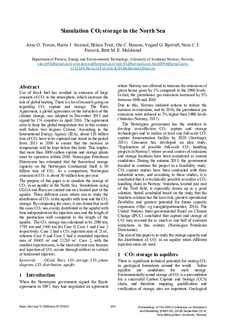| dc.contributor.author | Torsen, Arne O. | |
| dc.contributor.author | Smistad, Harris J. | |
| dc.contributor.author | Tveit, Håkon | |
| dc.contributor.author | Hansen, Ole C. | |
| dc.contributor.author | Bjørtuft, Vegard G. | |
| dc.contributor.author | Furuvik, Nora Cecilie Ivarsdatter | |
| dc.contributor.author | Moldestad, Britt Margrethe Emilie | |
| dc.date.accessioned | 2019-01-15T09:44:33Z | |
| dc.date.available | 2019-01-15T09:44:33Z | |
| dc.date.created | 2018-11-29T17:18:09Z | |
| dc.date.issued | 2018 | |
| dc.identifier.citation | Linköping Electronic Conference Proceedings. 2018, (153), 255-262. | nb_NO |
| dc.identifier.issn | 1650-3686 | |
| dc.identifier.uri | http://hdl.handle.net/11250/2580620 | |
| dc.description | Proceedings of The 59th Conference on Simulation and Modelling (SIMS 59), 26-28 September 2018, Oslo Metropolitan University, Norway | nb_NO |
| dc.description.abstract | Use of fossil fuel has resulted in emission of large amounts of CO2 to the atmosphere, which increases the risk of global heating. There is a lot of research going on regarding CO2 capture and storage. The Paris Agreement, a global agreement on the reduction of the climate change, was adopted in December 2015 and signed by 174 countries in April 2016. The agreement aims to keep the global temperature rise in this century well below two degrees Celsius. According to the International Energy Agency (IEA), about 120 billion tons of CO2 have to be captured and stored in the period from 2015 to 2050 to ensure that the increase in temperature will be kept below this limit. This implies that more than 3000 carbon capture and storage plants must be operative within 2050. Norwegian Petroleum Directorate has estimated that the theoretical storage capacity on the Norwegian Continental Shelf is 80 billion tons of CO2. As a comparison, Norwegian emission of CO2 is about 50 million tons per year. The purpose of this paper is to simulate the storage of CO2 in an aquifer in the North Sea. Simulations using OLGA and Rocx are carried out on a limited part of the aquifer. Three different cases where run to study the distribution of CO2 in the aquifer with time and the CO2 storage. By comparing the cases, it was found that in all the cases CO2 was evenly distributed in the aquifer with time independent on the injection area and the length of the production well compared to the length of the aquifer. The CO2 storage was calculated to be 2590 ton, 3795 ton and 2560 ton for Case 0, Case 1 and Case 2 respectively. Case 2 had a CO2 injection area of 21m2, whereas Case 0 and Case 1 had a simulated injection area of 10605 m2 and 21210 m2. Case 2, with the smallest injection area, is the most relevant case because real injection of CO2 occurs through orifices in vertical or horizontal injectors. | nb_NO |
| dc.language.iso | eng | nb_NO |
| dc.rights | Navngivelse-Ikkekommersiell 4.0 Internasjonal | * |
| dc.rights.uri | http://creativecommons.org/licenses/by-nc/4.0/deed.no | * |
| dc.title | Simulation of CO2 storage in the North Sea | nb_NO |
| dc.type | Journal article | nb_NO |
| dc.type | Peer reviewed | nb_NO |
| dc.description.version | publishedVersion | nb_NO |
| dc.source.pagenumber | 255-262 | nb_NO |
| dc.source.journal | Linköping Electronic Conference Proceedings | nb_NO |
| dc.source.issue | 153 | nb_NO |
| dc.identifier.doi | 10.3384/ecp18153255 | |
| dc.identifier.cristin | 1637147 | |
| cristin.unitcode | 222,58,3,0 | |
| cristin.unitname | Institutt for prosess-, energi- og miljøteknologi | |
| cristin.ispublished | true | |
| cristin.fulltext | original | |
| cristin.qualitycode | 1 | |

